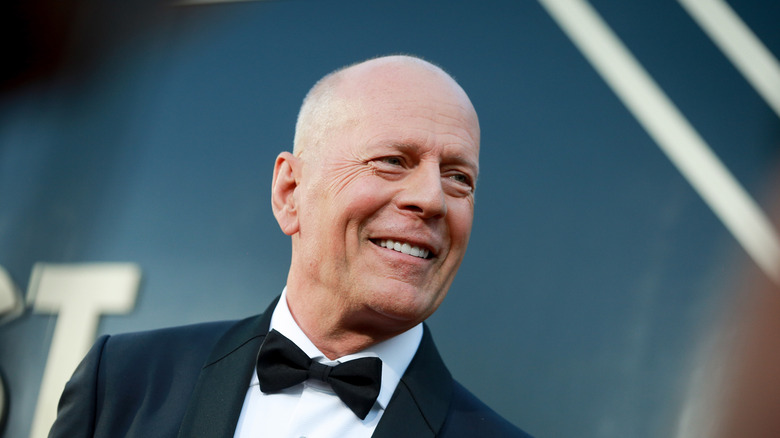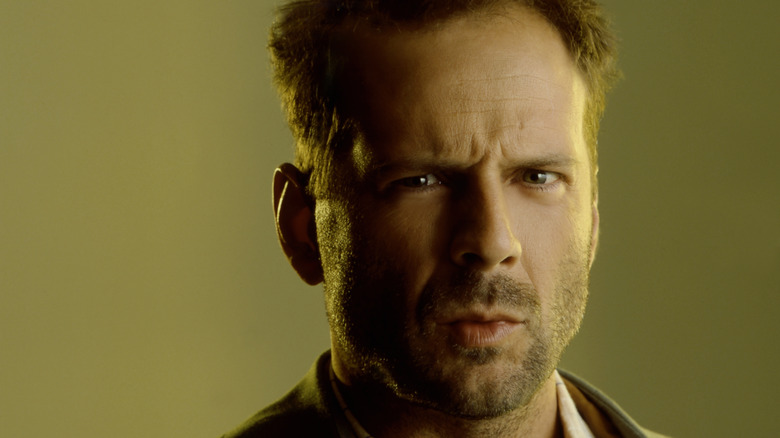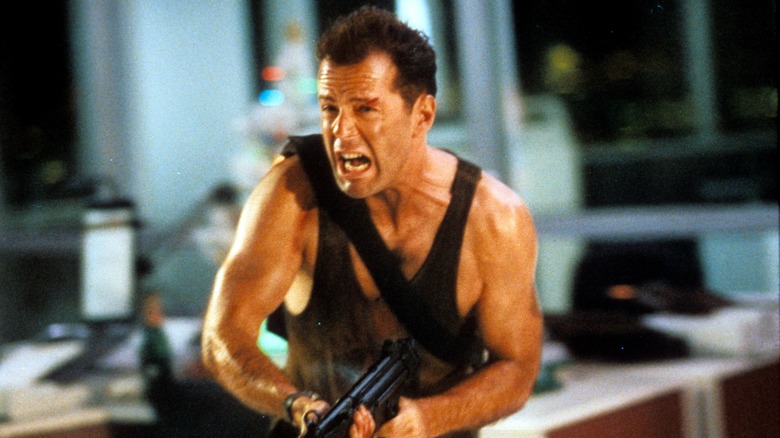How Bruce Willis Changed Hollywood Actors' Pay Forever
Pay rates in Hollywood are weird, as Vanity Fair can tell you. Awards, reviews, box office take, and the aggressive lobbying of agents all come together to determine a Hollywood actor's "quote," or the minimum fee that entices them to say yes to a project. The acceptable pay range for a major star has evolved over the years, with precedents often set by lone performers tenacious enough (or lucky enough) to make spectacular deals. In 1916, Mary Pickford became the highest-paid actress in Hollywood with $1,000 a week (per Money Week), which translates to about $28,000 in 2023. Making $1 million per picture became possible when Elizabeth Taylor got that fee for "Cleopatra" (per Turner Classic Movies). And in 1988, Bruce Willis scrambled the studios' pay scheme pyramid with what he took home for "Die Hard" — $5 million (per The New York Times), or the equivalent of $12 million in 2023.
Willis was a last-minute choice for the part of John McClane, according to Brian Abram's "Die Hard: An Oral History" (via The Washington Post). Harrison Ford, Arnold Schwarzenegger, Clint Eastwood, and Sylvester Stallone had all turned the part down. So had Frank Sinatra, whose 1968 vehicle "The Detective" "Die Hard" was originally written as a sequel to. Willis was nowhere near their level of fame when he was cast, nor was he yet known for his work in action films. He was most known at the time for "Moonlighting," a TV comedy. His $5 million salary was less earth-shattering for its number than the fact that he got it at that point in his career.
Bruce Willis's fee for Die Hard was considered excessive for a TV star
At the time that Bruce Willis was cast in "Die Hard," earning $5 million for one picture was considered appropriate for the biggest stars, not up and coming actors who worked in television — a medium several decades away from its current revered status. Per The New York Times, the precedent for $5 million had been set by Dustin Hoffman in 1982, when he was paid slightly north of that for "Tootsie." But Hoffman was a major movie star at the time. Willis had one credited film role before "Die Hard."
His $5 million payday rankled studio executives and agents, for the same reason: if a TV actor was making that kind of money, what were the big stars going to ask for in response? Agents felt obligated to fight for higher quotes for their clients, and studio executives worried about the precedent being set. The heads of rival studios openly expressed astonishment and worry over what 20th Century Fox had done, especially given that early testing indicated audiences weren't excited for the everyman type of hero Willis wanted to play (per The Washington Post).
Willis's salary was justified by Die Hard's performance
Against industry backlash, 20th Century Fox producer defended what he'd paid Bruce Willis for "Die Hard," telling The New York Times that it was the type of film that could become a star vehicle and that the suits at Fox saw potential in Willis. In an interview for Closer, Willis offered his own defense for his paycheck: "It's an old strategy called 'you get what you can get.' We didn't put a gun to anybody's head. In a town and an industry where all this can be gone next year, you take what you can get. You get what you can ... they paid me what they thought I was worth for the film and for them."
Willis and his representation might not have been overly aggressive in negotiations, but being such a late choice on a project so many bigger stars had passed on may have helped his position, given how desperate Fox was to get the film made. With "Die Hard" ultimately making $148 million against a $28 million budget, any doubts about Willis's worth as a star melted away. "In this crazy world we live in, Bruce was worth the money, every penny," producer Larry Gordon told the Times shortly before the film entered general release. The same article reported that however "Die Hard" performed, $5 million would remain Willis's quote going forward in his career.


